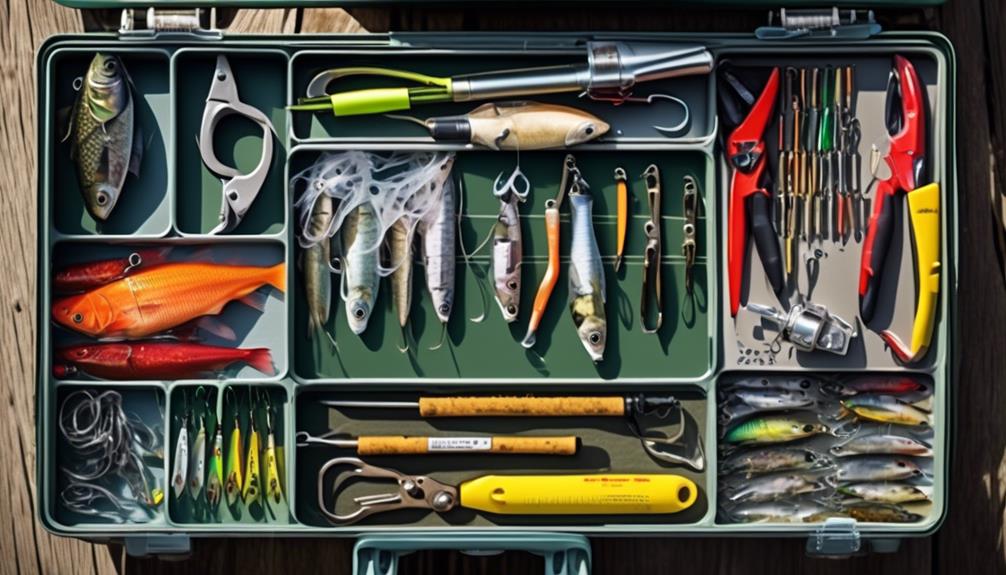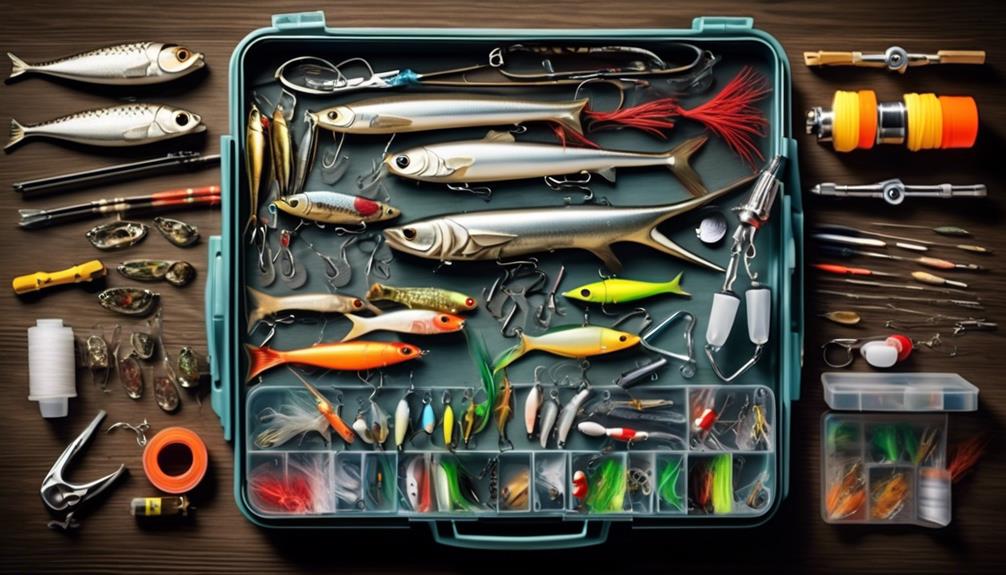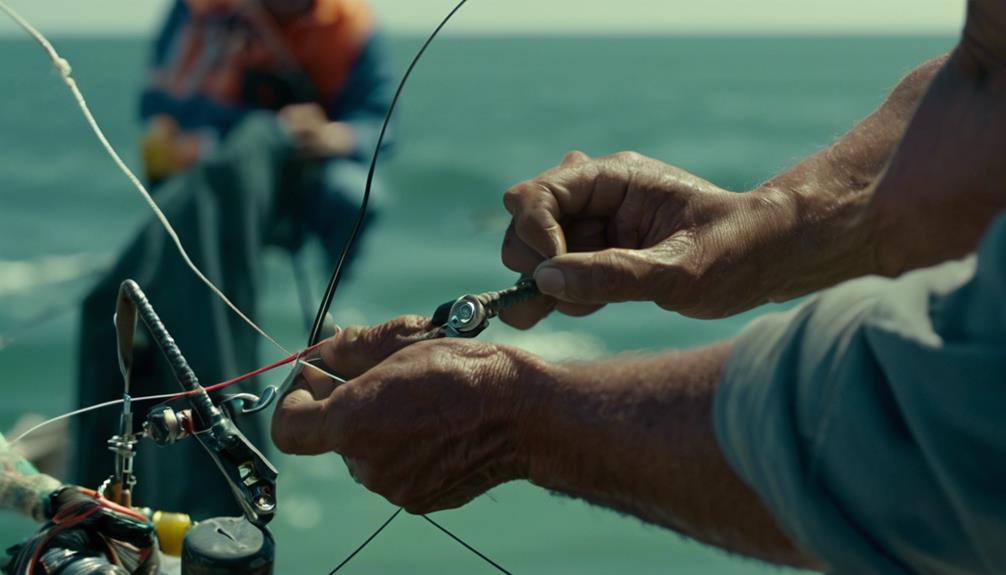Setting up your saltwater fishing tackle requires precision and patience. Whether you're a novice angler or a seasoned saltwater fishing enthusiast, the proper setup can make all the difference in your success on the water.
From selecting the right rod and reel to understanding the intricacies of terminal tackle, this guide will walk you through each step of the process.
So, are you ready to elevate your saltwater fishing game and reel in some impressive catches?
Rod and Reel Selection
When selecting your rod and reel for saltwater fishing, consider the type of fish you'll be targeting and the fishing conditions you'll encounter. For rod selection, it's crucial to match the rod's power and action to the species you intend to catch. A heavier rod is suitable for larger, more powerful fish, while a lighter rod provides more flexibility and sensitivity, ideal for smaller species. Additionally, the length of the rod affects casting distance and leverage when fighting fish. Longer rods generally cast farther, while shorter ones offer better control when fighting fish in tight spaces.
Now, let's shift our focus to reel maintenance. Proper care of your reel is essential for its longevity and performance. After each fishing trip, rinse the reel with fresh water to remove salt and debris. Then, wipe it down with a soft cloth and apply a light coat of reel oil to the moving parts. This routine maintenance prevents corrosion and ensures smooth operation. Periodically, disassemble the reel for a thorough cleaning and lubrication. This process helps to identify any worn or damaged parts that may need replacement. Lastly, store your reel in a cool, dry place away from direct sunlight to maintain its condition.
When considering both rod selection and reel maintenance, remember that a well-maintained reel paired with a properly selected rod increases your chances of success and enhances your overall saltwater fishing experience.
Choosing the Right Line
Selecting the right fishing line is crucial for saltwater angling success. When it comes to choosing the right line for saltwater fishing, several factors should be considered to ensure you're well-equipped for the challenges of the open sea.
- Line Strength: Opt for a fishing line with high strength to withstand the powerful pulls of saltwater game fish. Look for lines that are specifically designed for saltwater fishing, as they're often more durable and have higher tensile strength to handle the aggressive behavior of saltwater species.
- Durability: Saltwater can be harsh on fishing lines, so durability is key. Look for lines that are resistant to abrasion and have high UV resistance to prevent damage from the sun's rays. Additionally, consider lines with good shock strength to handle sudden bursts of energy from large saltwater fish.
- Knot Tying Techniques: Learn and practice reliable knot tying techniques to ensure that your line is securely attached to your hooks, swivels, and leaders. Opt for strong and reliable knots such as the Palomar knot, Uni knot, or Improved Clinch knot, as they're known for their strength and reliability in saltwater fishing scenarios.
- Tips: When spooling your reel with a new line, make sure to spool it tightly and evenly to prevent line twists and tangles. Additionally, consider using a monofilament or fluorocarbon leader to provide extra protection against the sharp teeth and abrasive mouths of saltwater game fish.
Picking the Perfect Lures
To optimize your saltwater fishing tackle, ensuring that your lures are well-suited for the aggressive nature of saltwater game fish is essential. When picking the perfect lures, it's important to consider both lure presentation and experimentation.
Saltwater game fish are known for their aggressive nature, so selecting lures that can withstand their powerful strikes is crucial. Experimentation with different lure sizes, shapes, and weights is also key to finding the perfect match for the specific species you're targeting.
Lure color and action are also vital factors to consider when picking the perfect lures for saltwater fishing. The color of the lure should mimic the natural prey of the fish you're targeting. For example, if you're fishing in clear waters where baitfish are abundant, choosing lures in silver, blue, or green hues may be effective. On the other hand, in murkier waters, lures in darker colors like black, purple, or even red may be more visible and attractive to game fish.
In addition to color, the action of the lure is crucial for enticing saltwater game fish. Different lures have varying actions, such as popping, diving, or fluttering, which can trigger aggressive strikes from predatory species. It's important to experiment with different actions to determine what works best for the specific conditions and species you're targeting.
Understanding Terminal Tackle
Mastering the use of various terminal tackle components is essential for successfully landing saltwater game fish. Understanding terminal tackle involves knowing how to tie knots and select the right weight for your fishing setup.
When it comes to tying knots, it's crucial to master a few reliable and secure options. The improved clinch knot is a popular choice for securing hooks, swivels, and lures to the line. Additionally, the Palomar knot is known for its strength and is ideal for securing braided line to terminal tackle. These knots are essential for ensuring that your tackle remains secure during the fight with a powerful saltwater game fish.
Weight selection is another critical aspect of terminal tackle. The weight of your terminal tackle depends on various factors, including the depth of the water, the strength of the current, and the target species. Using the correct weight will ensure that your bait or lure reaches the desired depth and remains in the strike zone, increasing your chances of enticing a bite.
Understanding terminal tackle components like tying knots and selecting the appropriate weight can make a significant difference in your saltwater fishing success. By mastering these fundamental aspects, you'll be better equipped to handle the challenges of saltwater fishing and increase your chances of landing that prized catch.
Setting Up Rigs and Leaders
When setting up rigs and leaders for saltwater fishing, consider the specific requirements of your target species and the fishing conditions. Start by choosing the right leader materials based on the strength and visibility needed for the species you're targeting. Common leader materials include monofilament, fluorocarbon, and wire.
Next, familiarize yourself with essential knot tying techniques such as the improved clinch knot and the Palomar knot, which are essential for securing hooks, swivels, and attaching the leader to the mainline.
Select weight and sinker options based on the water depth, current, and the type of bait or lure you'll be using. For example, if you're fishing in deep waters with strong currents, heavier sinkers are necessary to keep the bait at the desired depth. Conversely, lighter sinkers are suitable for shallow waters or when using live bait that needs to swim more freely.
Additionally, consider hook sizes that match the bait you plan to use and the size of the fish you're targeting. Larger hooks are suitable for bigger baits and larger fish, while smaller hooks are ideal for smaller baits and fish species.
Understanding these fundamental aspects of setting up rigs and leaders will significantly improve your chances of a successful saltwater fishing experience. By tailoring your rig and leader setups to the specific conditions and target species, you can enhance your effectiveness and increase the likelihood of a rewarding catch.
Rigging Your Bait
Consider using a loop knot for rigging your bait, as it allows for natural movement and can enhance the presentation to potential catches. A loop knot provides your bait with the freedom to move in a lifelike manner, making it more attractive to predatory fish.
When rigging your bait, it's crucial to consider the bait presentation to increase your chances of a successful catch. Here are some live bait techniques to improve your bait presentation:
- Match the Hatch: Choose a bait that closely resembles the natural prey in the area where you're fishing. This will make your bait appear more natural and increase its appeal to the fish.
- Proper Hook Placement: Ensure that the hook is strategically placed in the bait to allow for natural movement. This will also help in presenting the bait in a realistic manner to potential catches.
- Use the Right Size: Select a hook that's appropriate for the size of the bait. Using a hook that's too large or too small can affect the natural presentation of the bait.
- Consider Adding Scent: Adding scent to your bait can further enhance its presentation. The scent can attract fish and make them more likely to strike at your bait.
Essential Accessories and Tools

To ensure your success in saltwater fishing, having the right essential accessories and tools is crucial. Tackle organization and storage are essential for keeping your gear in top condition and readily accessible. Invest in a tackle box with adjustable compartments to keep your lures, hooks, weights, and other small items organized. Consider a waterproof tackle bag for larger items and extra spools of line. This will help you stay organized and prevent valuable time on the water from being wasted searching for specific gear.
Proper cleaning and maintenance are also crucial for the longevity of your saltwater fishing tackle. After each use, rinse your rods, reels, and other equipment with fresh water to remove salt and sand that can cause corrosion and damage. Store your rods and reels in a cool, dry place to prevent rust and other forms of deterioration. Additionally, regularly check and lubricate the moving parts of your reels to ensure smooth operation and longevity.
Investing in a good pair of pliers and a hook remover is also essential for saltwater fishing. These tools will help you safely remove hooks from fish, as well as make quick adjustments to your rig without damaging your gear or injuring yourself. A reliable fish grip or landing net can also make it easier to handle and release fish without causing harm.
Maintenance and Storage Tips
Invest in a sturdy tackle box with adjustable compartments to keep your saltwater fishing gear organized and readily accessible, and ensure its longevity with proper cleaning and maintenance. Saltwater fishing tackle can be prone to damage from exposure to salt and moisture, so taking care of your gear is crucial for preserving its performance and lifespan.
Here are some maintenance and storage tips to help you keep your saltwater fishing tackle in top condition:
- Tackle organization: Use a tackle box with adjustable dividers to separate different types of lures, hooks, weights, and other tackle. This won't only keep your gear organized but also prevent items from getting tangled or damaged during transport.
- Rust prevention: After each fishing trip, thoroughly rinse your rods, reels, and other metal components with freshwater to remove any salt residue. Wipe them down with a soft cloth to ensure they're completely dry before storing them. Additionally, consider using a corrosion inhibitor spray or applying a light coat of reel oil to metal parts to prevent rust and corrosion.
- Proper storage: Store your tackle box and fishing rods in a cool, dry place to prevent mold, mildew, and corrosion. Avoid leaving them in direct sunlight or damp areas, as prolonged exposure to these conditions can accelerate wear and tear.
- Regular maintenance: Inspect your gear regularly for any signs of damage or wear, and address any issues promptly to prevent further deterioration.
Frequently Asked Questions
What Are the Best Techniques for Casting and Retrieving When Saltwater Fishing?
When saltwater fishing, focus on smooth casting techniques to cover more ground and use efficient retrieving methods to mimic natural prey. Practice your casting accuracy and experiment with different retrieval speeds for best results.
How Do I Choose the Right Size and Type of Hook for Different Saltwater Fish Species?
When fishing in different depths, choosing the right hook size is crucial for catching saltwater fish. Consider the fish species, bait size, and water depth to select the appropriate hook size and type for a successful fishing trip.
What Are Some Common Mistakes to Avoid When Setting up Rigs and Leaders for Saltwater Fishing?
When setting up your rig for saltwater fishing, avoid common mistakes like using improper knots and selecting the wrong leader. These can lead to lost fish. Ensure your rig setup is strong and suited to the fish species you're targeting.
How Can I Properly Store and Maintain My Saltwater Fishing Tackle to Ensure It Lasts for Many Seasons?
To properly store and maintain your saltwater fishing tackle, keep it in a cool, dry place and clean it after each use. Inspect for corrosion, lubricate moving parts, and replace worn components to ensure it lasts for many seasons.
Are There Any Specific Safety Tips or Regulations to Be Aware of When Saltwater Fishing From a Boat or Shore?
When saltwater fishing from a boat or shore, it's important to be aware of safety regulations and follow them for a safe and enjoyable experience. Additionally, understanding shore fishing techniques can enhance your fishing success.
Conclusion
Now that you have all the right gear and knowledge, you're ready to hit the saltwater and enjoy some great fishing!
Remember to take care of your tackle, keep your lines and hooks sharp, and always be prepared for whatever the ocean throws at you.
With the right setup and some practice, you'll be reeling in the big ones in no time.
Good luck out there!



